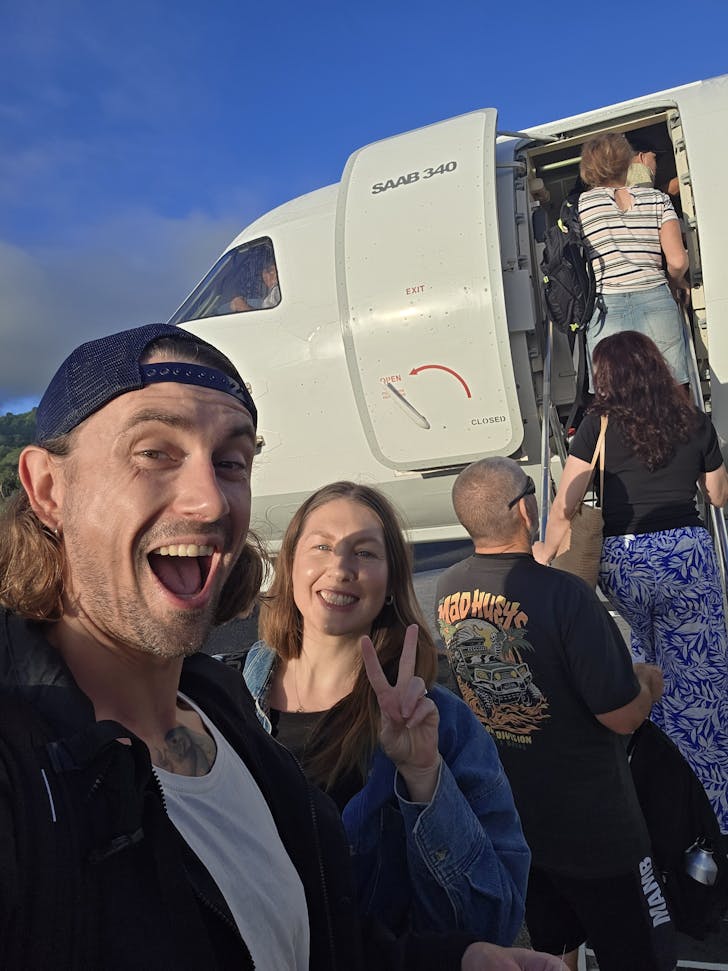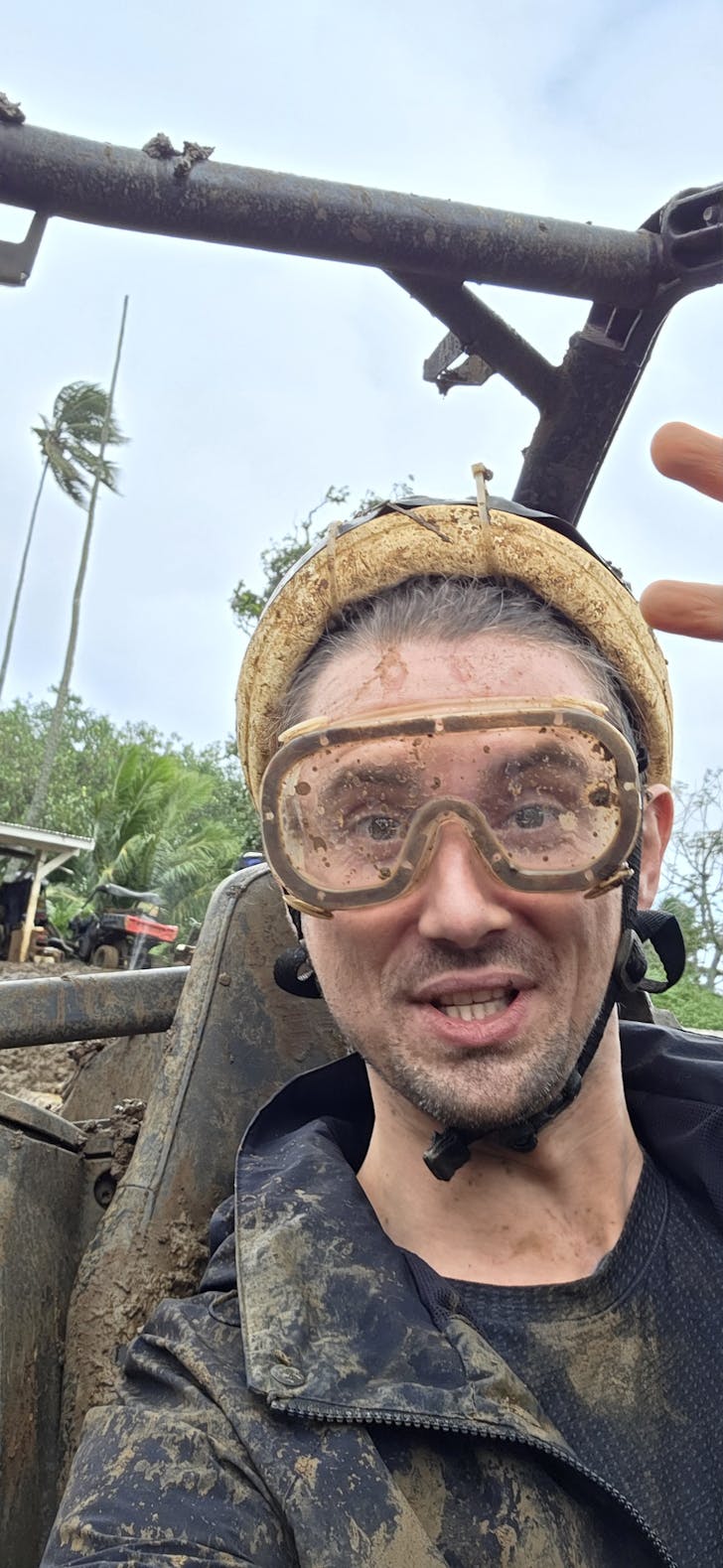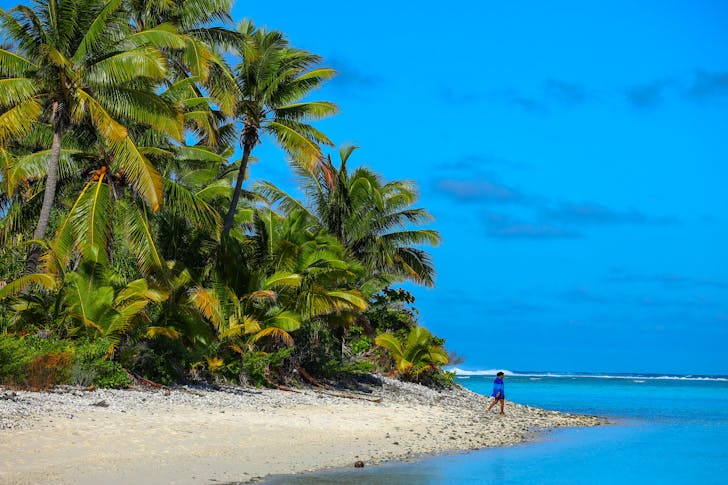From Pristine Beaches To Cultural Cookouts, This Island Paradise Is Even Better Than The Maldives
Paradise? It’s the Cook Islands. Seriously.
This tiny Pacific nation delivers beaches that rival the Maldives and Bora Bora—minus the overwhelm and plus the eco-conscious, slow-living vibe everyone’s trying to copy. Throw in a hearty-meets-tropical food scene and you’ve got yourself a week away you’ll be talking about for years.
You’ll find everything from world-class snorkelling to bangin’ burgers (your first stop: the famous ‘wet burger’ from Palace Takeaways), chaotic buggy tours, lagoon cruises and deep, genuinely moving cultural experiences—but more on that in a second.
If you're after a cheat sheet, we've made it easy, you can jump to exactly what you need:
- How To Get To The Cook Islands
- Where To Stay On The Cook Islands
- What To Do On The Cook Islands & Rarotonga
- What To Eat On The Cook Islands
- Where To Drink On The Cook Islands
- Where To Shop & Graze On Rarotonga
- What Makes The Cook Islands So Special
- FAQs
So, who are the Cook Islands for?
If a tropical holiday is your non-negotiable, you’re already halfway there. The Cooks are for travellers who want the perfect mix of adventure and relaxation; think snorkelling, island-hopping, cruising, mud buggies, hiking, beach-bumming and eating—lots of eating. It’s the Robinson Crusoe fantasy you thought those other island holidays would be. (Yes, Fiji, we are talking about you.)
Getting There
It’s not a bad hop from Australia—closer to NZ culturally and geographically, but still an easy escape for us. You’re looking at around seven hours from Sydney, or around ten from Melbourne via connections. Jetstar flies up to four times weekly from Sydney and return fares start at roughly $1,000 per person, but do go on sale, while Brissie you can head out three times a week from May 2026.
When you touch down, you’re hit with pure island hospitality: locals greeting slightly bleary travellers with eis, the Cook Islands version of a Hawaiian lei. Bags appear almost immediately, customs is a breeze and your resort transfer or rental car is usually waiting.

We grabbed a compact SUV from Polynesian Car Rentals and were on the road in minutes. Rarotonga runs on a ring road—about 50km all up—which means you can drive the entire island in roughly an hour (longer if you get stuck behind an island bus enjoying the view). The speed limit’s 50km/h, which is honestly perfect because you’ll want to rubberneck every beach, eatery and hidden staircase along the way.
Where To Stay
We checked into Club Raro, an adults-only, mid-range resort on the north side with a pool, a swim-up bar and an elite-level happy hour. Our poolside room was cool, clean and exactly what you want before a week of island adventures.
What To Do (AKA: A Lot)
Once you’re settled, prepare to be overwhelmed—in a good way. Here’s the essential hit list:
1. The Aitutaki Day Tour (Non-Negotiable)
This is the one you’ve seen all over social feeds. Aitutaki is one of the most beautiful lagoons in the world—full stop. The tour includes a lagoon cruise, beach BBQ, snorkelling, island hopping and some of the funniest locals you’ll ever meet. If you only do one day trip, do this.
2. Raro Buggy Tours
Pure chaos in the best way. The tour originally tore through an abandoned resort—rumoured to be cursed due to a historic family feud (ask a local; it’s spicy)—but now runs on purpose-built mud tracks that guarantee you’ll finish absolutely caked in gack. You’ll feel five years old again.

3. Progressive Dinner
An intimate cultural highlight. You’re welcomed into local homes, fed like family and told stories that give you a genuine feel for life on the islands. Banana curry sounds weird; it’s not—eat it.
4. Snorkelling Everywhere
The island’s ring reef creates protected, family-friendly snorkelling conditions almost everywhere. Top picks: Muri Beach and Black Rock. Pack your own mask if you’re keen, but rentals are everywhere.
5. A Fat Lap Of The Island
There is a lot to do around the island, but it is an island, don’t forget. Stop and grab some roadside bananas or a coconut, soak up the coffee culture, perch up at a cafe and generally soak up the vibes. You’ll have to drive while you’re here so definitely hit up Polynesian Rental Cars & Bikes so you don’t have to wait for the bus. Or do, it’s cheap as chips and frequent!
And that’s just scratching the surface, there’s the Cross-Island Trek, kite-surfing, sailing, GT fishing (the GTs at Aitutaki do not play—watch your toes), stand-up paddleboarding, local brewery visits and endless beaches to explore.
What To Eat
Everything. I mean, I say this as an obsessed, only travels with my stomach kinda guy, but seriously.
The ika mata (coconut and lime sashimi situation) is excellent likewise any seafood.
If you’re after restaurant recs I’d definitely hit up Muri Night Market, Rarotonga Brewery, Vaiana's (bonus points if you hang out until it turns into a club), Trader Jack's, Tamarind House (don't look at the prices, just go), Vili's Burger Joint, Palace Takeaways, Vibe Fish Van, The Lucky Rooster, Silversands Restaurant and Bar and basically just anywhere someone gives you a nudge to go.
Also, RFC (the Cook's take on KFC) is worth a cheeky visit, especially if you're a bit dusty after catching the party bus around the island.
Where To Drink
Boozin’ isn’t as big as you’d suspect on this particular tropical island. Lots of places have great sessions and happy hours on, which tends to be the theme—follow the happy hour around or pick up a slab and some spirits, that’s more the done thing.
Where To Shop & Graze
A must-do is the Punanga Nui Market in Avarua. Bring cash and extra bags—you’ll want everything. The banana or pumpkin poke (not the sashimi kind), local honey, Paul’s Rarotonga Hot Sauce, pareu (sarongs) and pearls make excellent take-homes. Food stalls turn out some of the best eats on the island.
Why It’s All So Special
The Cook Islands sit west of Tahiti and south of Hawaii, with strong cultural and historical ties to New Zealand. Locals often joke that NZ and Australia are the 16th and 17th islands of the group, thanks to the massive diaspora—15,000 locals in the Cooks vs. over 100,000 abroad.

But the people who stay (and many who move back) are deeply passionate about home. Tourism is the lifeblood of the islands—around 160,000 visitors passed through in 2023–24—but they’re intentional about preserving culture, environment and local life.
Right now, most tourists are Kiwis, sharing ancestry, language and history with Cook Islanders. But Aussies are the fastest-growing market—and once you visit, you’ll see why.
Right, now for the FAQS:
Who should go to the Cook Islands?
Anyone chasing an easy, ultra-laid-back island escape. Think couples, friend groups, swimmers, snorkellers, honeymooners, and anyone who wants Fiji-vibes without the crowds or the resort-hustle.
What’s the weather in the Cook Islands?
Warm year-round. Expect a dreamy 26°C during high season (our winter) and steamy mid-30s in summer, but please be ready for tropical downpours.
What currency do they use in the Cook Islands?
New Zealand Dollars—plus the occasional Cook Islands–minted coin you’ll probably want to take home as a souvenir. Ask a local about the story behind this, it's a belter.
How much do things cost on the Cook Islands?
Pretty similar to Australia. Meals, tours and cocktails lean holiday-expensive, but buses and local eats keep things reasonable. Budget for island prices, not city prices.
Do I need a travel SIM for the Cook Islands?
Yes—unless you’re planning a full digital detox. Grab a Vodafone visitor SIM at the airport for reliable coverage across Rarotonga.
How do you get around Rarotonga and the Cook Islands?
Easy. There’s a loop bus that runs clockwise and anticlockwise, scooters everywhere, and plenty of car and e-bike rentals. The whole island takes about an hour to lap.
What activities are there on the Cook Islands?
Snorkelling, lagoon cruises, scuba diving, hiking, night markets, cultural shows, and eating your way through fresh island-style BBQs. It’s a choose-your-own-paradise situation.
What to do on rainy days in Rarotonga?
Hit the cafés, check out local galleries, book a spa session, or wander the markets under cover. Tropical rain is usually short and dramatic—not a day-ruiner.
Is there a McDonald’s on Rarotonga?
Nope—cheeseburgers are strictly DIY. But the local takeaway joints more than make up for it.
What language do they speak in the Cook Islands?
English and Cook Islands Māori. You’ll hear a mix of both, with locals happy to teach you a phrase or two.
What’s the time difference in the Cook Islands?
They’re roughly 20 hours behind Australia’s east coast—so it basically feels like you’ve time-travelled back a day.
Our writer travelled thanks to Cook Islands Tourism and Jetstar, however everything within this article gets the Urban List tick of approval, from food to activities. To start planning your itinerary, hit up the Cooks' website.

.jpg?format=auto,compress&w=728 728w)

.jpg?format=auto,compress&w=728 728w)
.jpg?format=auto,compress&w=728 728w)

